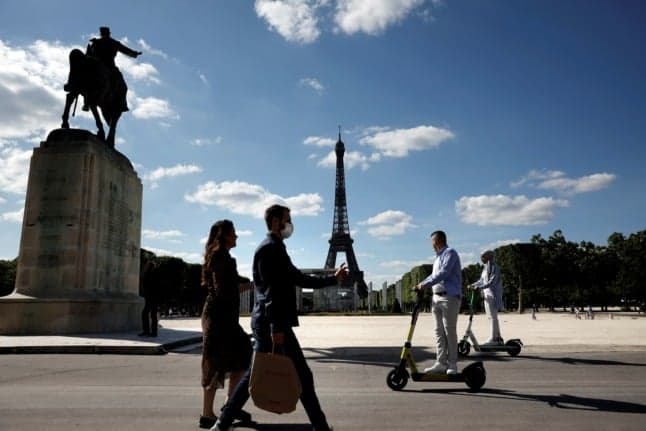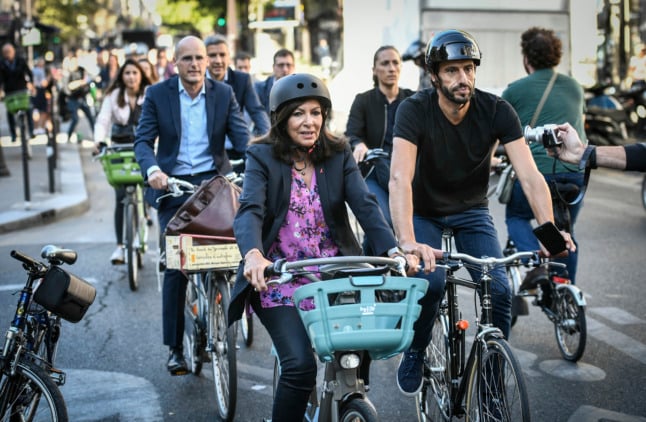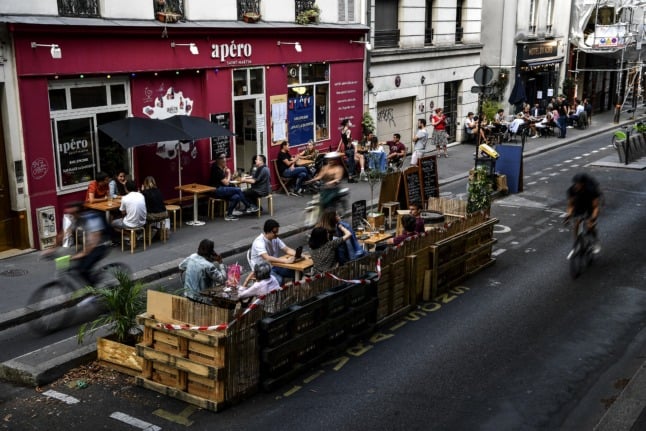Cycle lanes, scooters and terraces - is Paris still safe for pedestrians?

The recent death of a woman who was hit by an electric scooter has sparked a debate about whether it’s safe to be a pedestrian in Paris in 2021. We took to the streets to see how the locals feel.
Over the past few years Paris has been undergoing a major change as cars are pushed out and greener transport like bikes and scooters are encouraged.
But the death of a 32-year-old Italian woman who died after she was hit by an electric scooter has sparked debate over whether these changes have made the capital more dangerous than ever for pedestrians.
Is it really dangerous to walk in Paris?
Three pedestrians were killed in central Paris in the first five months of 2021, according to regional authorities.
15 pedestrians lost their lives in 2020, a slight decrease from 16 in 2019 and 19 in 2018. Walking (or using a skateboard or push scooter) was the most dangerous form of personal transport last year, since eight cyclists lost their lives, as well as 11 drivers and 11 riders of motorbikes, mopeds or electric personal transporters (eg scooters).
Much of the anger for this situation is directed at cyclists and people using the scooters which can be rented all over the city and are an increasingly common sight.
However, of the 15 deaths last year, eight were caused by cars or vans, three were caused by heavy goods vehicles, and another two by motorcycles or mopeds. Only one of the accidents involved a cyclist, and one involved a personal transporter such as an electric scooter or hoverboard.
What the city is doing
In response to the fatal accident in June, city hall threatened to ban e-scooters if operators don't enforce speed limits and other rules. Since last week, these rules include ensuring speeds do not exceed 10 km/h in several "slow zones" in central Paris, where operators will be able to ensure these limits are programmed into the GPS units so that they come on automatically.
Paris had already banned users from leaving electric scooters on the pavement, after complaints from residents that the devices were blocking paths city-wide.

Mayor Anne Higalgo made cycling a central tenet of her 2020 re-election campaign. Photo: STEPHANE DE SAKUTIN / AFP.
At the same time, mayor Anne Hidalgo has made reducing the number of cars on the roads a central objective of her tenure. Upon her election in 2014, the socialist set about creating new cycle lanes and pedestrianising several major public squares, and she is hoping to create a "low traffic zone" in the city centre in 2022.
During the pandemic, Paris created 60 kilometres of temporary "coronapiste" bike lanes, which are often little more than orange markings on existing roads, although work will begin this month to transform them into permanent cycle lanes. The coronapistes have drawn criticism from certain residents who believe they are unsafe and/or ugly, and who have expressed they displeasure using the hashtag SaccageParis.
According to France Info, the number of cyclists on the roads in September 2020 was 66 percent higher than over the same period in 2019, with many people hesitant to return to public transportation after the pandemic.
Why people are annoyed
For some Parisians, this just means more modes of transport to worry about.
Annie, 74, preferred it when there were mainly cars on the road.
"Cyclists go past all the time, whether it's red or green, and on top of that they come from both directions, so when you cross, you need to pay attention to properly look left and right," she said.
https://twitter.com/ldemonneron/status/1383806117050945547
Clara Malkassian, a parent living around the now semi-pedestrianised Canal St-Martin in the 10th arrondissement, says the move to push out cars has its plus points but there are downsides.
"I think the pedestrianisation is great when it comes to lowering noise around the canal and it gives a certain sense of tranquility, but if you are walking with your kids to school, crossing the road has become far more dangerous. Unfortunately the cyclists and scooter riders don't respect the red lights at all and that means it's become more dangerous for children."
Another parent, Lotfi, who lives in the same area, added: "They need to put up signs warning cyclists and electric scooter riders that they need to be aware of pedestrians and slow down. It's become dangerous."
Complaints about the behaviour of two-wheeled road users are a common refrain in the capital.
"As a cyclist myself, I use the cycle lanes and see lots of people on bikes and scooters, and unfortunately I see lots who ride any which way, who have little knowledge of the highway code," said Quentin, 44, who works near the Palais-Royal.
"I've found that since last year, since the end of lockdown, a lot of people have started travelling by bike or by scooter, and since there are a lot of road works at the moment, there are certain areas which are pretty dangerous, and when you're on foot you have to be pretty careful."
READ ALSO The tweets that show why Paris is fed up with scooter riders
Jean-Paul Lechevalier, vice-president of the 60 Millions de piétons (60 million pedestrians) association, said the decision to allow restaurants to extend their terraces into the street for the second summer in a row had made the situation worse.
"The problem is that nobody respects the rule about leaving 1.6 metres for people to pass, the pavements are completely colonised by terraces," Lechevalier told Le Parisien. "Result: pedestrians find themselves pushed onto the road, which is both scandalous and very dangerous."

An extended café terrace in Paris in July 2020. Photo: Christophe ARCHAMBAULT / AFP.
"It's much more pleasant"
But if some people worry about speeding cyclists, others are enjoying the quieter streets and drop in air pollution that has come about with the loss of cars.
Eve, 19, feels safer now there are fewer cars, although she was also relieved to see speed limits introduced for electric scooters. "It's true that some of them used to go very fast, and the big problem with bikes and scooters is when they ride on the pavement."
On her lunch break in the Jardin des Tuileries, Eve gestured towards the nearby Rue de Rivoli, a 3 kilometre-long road which recently became off-limits for most cars, with exceptions for buses, taxis and emergency vehicles. "There's a section for bikes and another for cars, so it's better now because as pedestrians we have more space on the pavement, since before the pavement was really shared with the bikes."
"When you think back to how it was, it was almost like a motorway, there were cars going very fast over four or five lanes, so now it's less dangerous, I think," added Quentin.
READ ALSO Is Paris close to achieving its goal of becoming a ‘world cycling capital’?
Further up Rue de Rivoli, towards the town hall, Ralph, 19, said he was in favour of more cycle lanes. "During lockdown, we truly realised that when there are no cars going past, it's much more pleasant."
However, he admits that not all areas are as clearly delineated as Rue de Rivoli. "On boulevard de Sébastopol, for example, the cycle line is right next to the pavement [...] Sometimes you don't really know where you're supposed to stop, so in the beginning it requires a bit of getting used to. But as long as you stay on the pavement and pay attention to the red light, there's no problem."
Anais, also 19, said she prefers walking in the neighbourhood around the town hall, compared to other areas where parked cars line the streets. "The fewer cars there are, the better, because it's much nicer in town. Even just in terms of noise, but also for the air quality and for safety."
Surely reducing pollution is a goal every Parisian can get behind?
"I don't notice the difference," said Lucette, 83, who has lived in the 12th arrondissement for most of her life. "Without pollution, I'd fall ill."
Comments
See Also
Over the past few years Paris has been undergoing a major change as cars are pushed out and greener transport like bikes and scooters are encouraged.
But the death of a 32-year-old Italian woman who died after she was hit by an electric scooter has sparked debate over whether these changes have made the capital more dangerous than ever for pedestrians.
Is it really dangerous to walk in Paris?
Three pedestrians were killed in central Paris in the first five months of 2021, according to regional authorities.
15 pedestrians lost their lives in 2020, a slight decrease from 16 in 2019 and 19 in 2018. Walking (or using a skateboard or push scooter) was the most dangerous form of personal transport last year, since eight cyclists lost their lives, as well as 11 drivers and 11 riders of motorbikes, mopeds or electric personal transporters (eg scooters).
Much of the anger for this situation is directed at cyclists and people using the scooters which can be rented all over the city and are an increasingly common sight.
However, of the 15 deaths last year, eight were caused by cars or vans, three were caused by heavy goods vehicles, and another two by motorcycles or mopeds. Only one of the accidents involved a cyclist, and one involved a personal transporter such as an electric scooter or hoverboard.
What the city is doing
In response to the fatal accident in June, city hall threatened to ban e-scooters if operators don't enforce speed limits and other rules. Since last week, these rules include ensuring speeds do not exceed 10 km/h in several "slow zones" in central Paris, where operators will be able to ensure these limits are programmed into the GPS units so that they come on automatically.
Paris had already banned users from leaving electric scooters on the pavement, after complaints from residents that the devices were blocking paths city-wide.

At the same time, mayor Anne Hidalgo has made reducing the number of cars on the roads a central objective of her tenure. Upon her election in 2014, the socialist set about creating new cycle lanes and pedestrianising several major public squares, and she is hoping to create a "low traffic zone" in the city centre in 2022.
During the pandemic, Paris created 60 kilometres of temporary "coronapiste" bike lanes, which are often little more than orange markings on existing roads, although work will begin this month to transform them into permanent cycle lanes. The coronapistes have drawn criticism from certain residents who believe they are unsafe and/or ugly, and who have expressed they displeasure using the hashtag SaccageParis.
According to France Info, the number of cyclists on the roads in September 2020 was 66 percent higher than over the same period in 2019, with many people hesitant to return to public transportation after the pandemic.
Why people are annoyed
For some Parisians, this just means more modes of transport to worry about.
Annie, 74, preferred it when there were mainly cars on the road.
"Cyclists go past all the time, whether it's red or green, and on top of that they come from both directions, so when you cross, you need to pay attention to properly look left and right," she said.
https://twitter.com/ldemonneron/status/1383806117050945547
Clara Malkassian, a parent living around the now semi-pedestrianised Canal St-Martin in the 10th arrondissement, says the move to push out cars has its plus points but there are downsides.
"I think the pedestrianisation is great when it comes to lowering noise around the canal and it gives a certain sense of tranquility, but if you are walking with your kids to school, crossing the road has become far more dangerous. Unfortunately the cyclists and scooter riders don't respect the red lights at all and that means it's become more dangerous for children."
Another parent, Lotfi, who lives in the same area, added: "They need to put up signs warning cyclists and electric scooter riders that they need to be aware of pedestrians and slow down. It's become dangerous."
Complaints about the behaviour of two-wheeled road users are a common refrain in the capital.
"As a cyclist myself, I use the cycle lanes and see lots of people on bikes and scooters, and unfortunately I see lots who ride any which way, who have little knowledge of the highway code," said Quentin, 44, who works near the Palais-Royal.
"I've found that since last year, since the end of lockdown, a lot of people have started travelling by bike or by scooter, and since there are a lot of road works at the moment, there are certain areas which are pretty dangerous, and when you're on foot you have to be pretty careful."
READ ALSO The tweets that show why Paris is fed up with scooter riders
Jean-Paul Lechevalier, vice-president of the 60 Millions de piétons (60 million pedestrians) association, said the decision to allow restaurants to extend their terraces into the street for the second summer in a row had made the situation worse.
"The problem is that nobody respects the rule about leaving 1.6 metres for people to pass, the pavements are completely colonised by terraces," Lechevalier told Le Parisien. "Result: pedestrians find themselves pushed onto the road, which is both scandalous and very dangerous."

"It's much more pleasant"
But if some people worry about speeding cyclists, others are enjoying the quieter streets and drop in air pollution that has come about with the loss of cars.
Eve, 19, feels safer now there are fewer cars, although she was also relieved to see speed limits introduced for electric scooters. "It's true that some of them used to go very fast, and the big problem with bikes and scooters is when they ride on the pavement."
On her lunch break in the Jardin des Tuileries, Eve gestured towards the nearby Rue de Rivoli, a 3 kilometre-long road which recently became off-limits for most cars, with exceptions for buses, taxis and emergency vehicles. "There's a section for bikes and another for cars, so it's better now because as pedestrians we have more space on the pavement, since before the pavement was really shared with the bikes."
"When you think back to how it was, it was almost like a motorway, there were cars going very fast over four or five lanes, so now it's less dangerous, I think," added Quentin.
READ ALSO Is Paris close to achieving its goal of becoming a ‘world cycling capital’?
Further up Rue de Rivoli, towards the town hall, Ralph, 19, said he was in favour of more cycle lanes. "During lockdown, we truly realised that when there are no cars going past, it's much more pleasant."
However, he admits that not all areas are as clearly delineated as Rue de Rivoli. "On boulevard de Sébastopol, for example, the cycle line is right next to the pavement [...] Sometimes you don't really know where you're supposed to stop, so in the beginning it requires a bit of getting used to. But as long as you stay on the pavement and pay attention to the red light, there's no problem."
Anais, also 19, said she prefers walking in the neighbourhood around the town hall, compared to other areas where parked cars line the streets. "The fewer cars there are, the better, because it's much nicer in town. Even just in terms of noise, but also for the air quality and for safety."
Surely reducing pollution is a goal every Parisian can get behind?
"I don't notice the difference," said Lucette, 83, who has lived in the 12th arrondissement for most of her life. "Without pollution, I'd fall ill."
Join the conversation in our comments section below. Share your own views and experience and if you have a question or suggestion for our journalists then email us at [email protected].
Please keep comments civil, constructive and on topic – and make sure to read our terms of use before getting involved.
Please log in here to leave a comment.